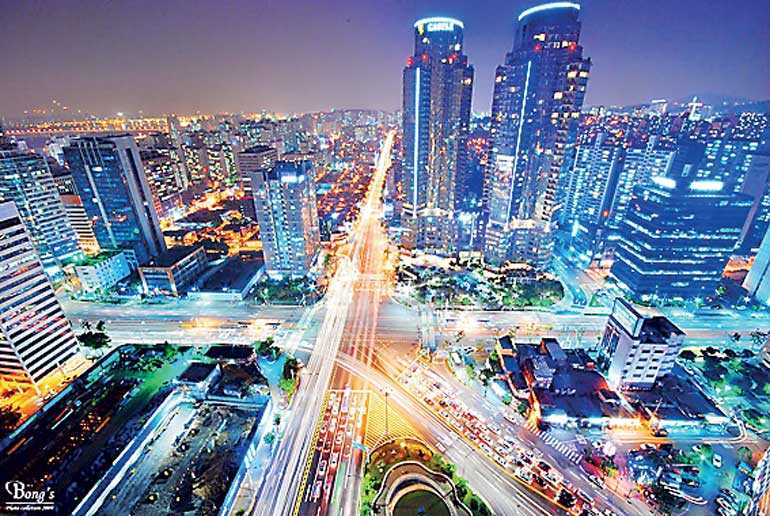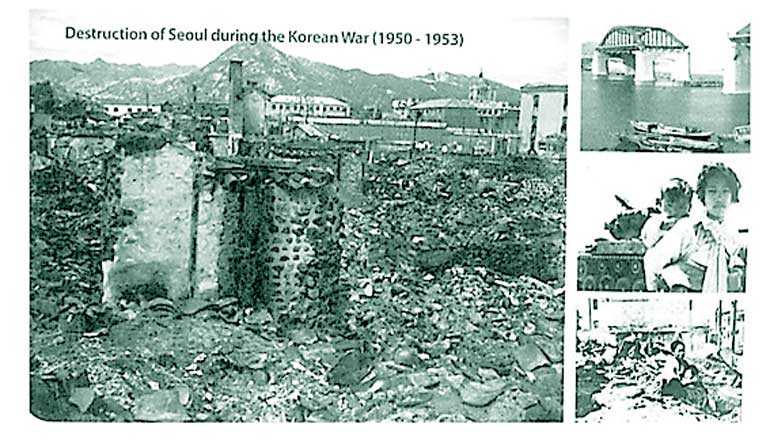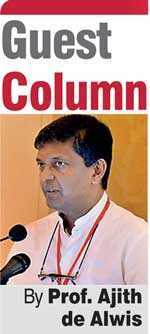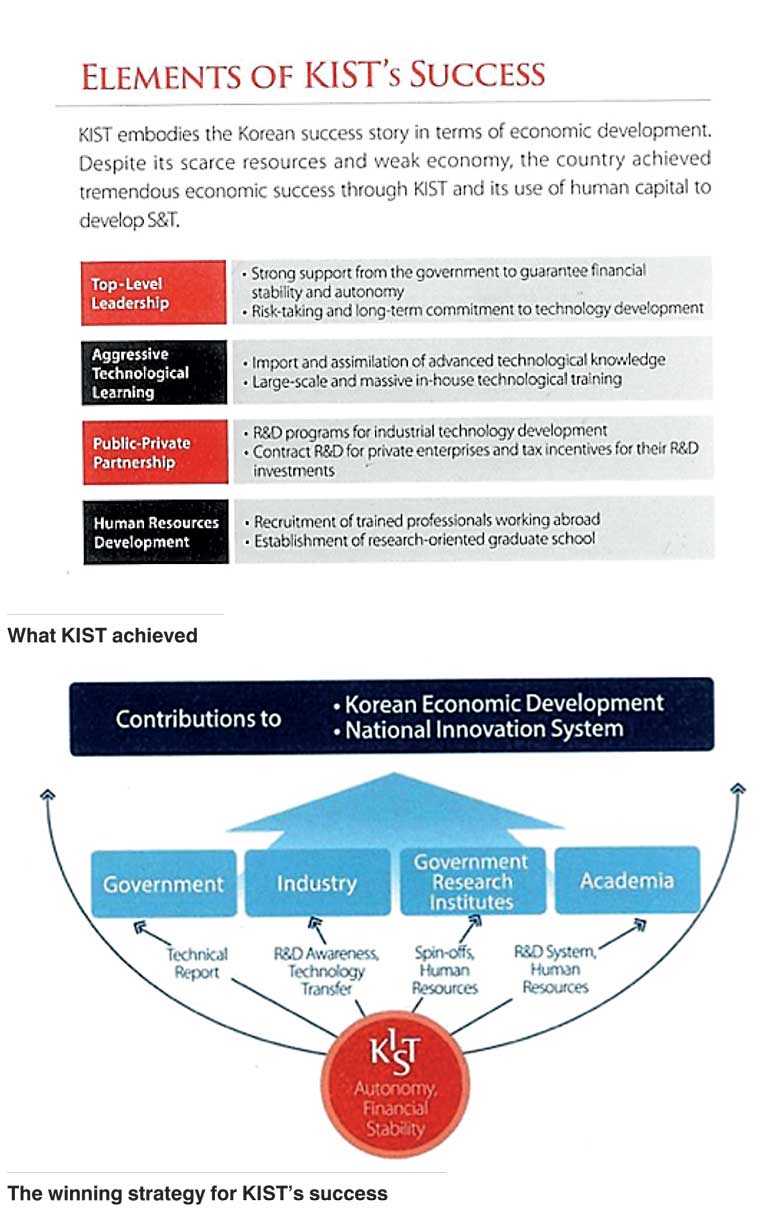Monday Apr 07, 2025
Monday Apr 07, 2025
Thursday, 11 October 2018 00:00 - - {{hitsCtrl.values.hits}}

If a country has grown with science and technology driven by its own internal research and development and deployment, Korea should enter into anyone’s mind – or does it? Certainly when one hears the story of the miracle on the Han river, the story is quite amazing and many a lesson are perhaps can be taken.
There is one catch – these lessons are not easy to emulate and do not come with recommendations for leisure and enjoyment but hard and smart work and also with sleepless nights and no golf either! A generation or two in Korea with concerted effort paved way for the following generations to achieve a different quality of life within an advanced society. We sadly only demonstrate our dancing prowess to Gangnam style and think we are with the times if we are doing that!
Having belittled Korea in early days, naming our slum areas as little Korea, we today queue in front of the Korean Embassy after diligently learning the language to seek relatively unskilled jobs. Sad indeed! Korea indeed was one of the least developed countries in the world following the Korean War (1950-1953) and the pictures from the era present really a grim picture. Douglas MacArthur, Commander in Chief of UN Forces in Korea, was on record having stated that the reconstruction of Korea would take at least a century! Koreans by act and deed rubbished that statement.
Korean GDP was only $ 80 in 1960. The difference today came in with the thinking of the decision makers, which includes politicians too. The Korean Government considered the advancement of Science and Technology (S&T) and the development of human resources to be the critical factors in advancing the country’s economy and that led to the establishment of KIST.
The idea came in with the understanding that Korea lacked both natural and financial resources and S&T was considered as the best option for the way forward. Blending human capital to develop S&T and through KIST the idea was proved right in couple of decades. I just cannot find such thinking from our archives. Hollow statements from hallowed premises appeared to have been the norm in many days in then Ceylon! Have we changed still is a moot question.

Korea Institute of Science and Technology
What is quite interesting is that central to this story of the Han miracle there is just one institute – KIST, which stands for Korea Institute of Science and Technology. KIST came up with the assistance of United States of America which happened consequent to a meeting on 18 May 1985 between Korean President Park Chung Hee and President Lyndon B. Johnson on US soil. When the two Heads of State met, they appeared to have discussed Science and Technology for Development and KIST became a reality. This too perhaps is unique.
KIST was founded in 1966 as the first comprehensive S&T research institute in Korea. Since then, KIST has been at the forefront of national development initially, of course carving out the reputation by doing just that!
KIST in early days acted as a think tank for the Government in developing national policies. Its input had been instrumental in forming the national S&T development plan and industrial development master plan. Initially research effort had been on meeting the technical needs of corporate entities in order to increase their market competitiveness.
Before the establishment of KIST, Korea had mainly relied on turnkey technologies brought in from overseas for product development, and product manufacturing. That development is possible and perhaps much more resilient through proper focused R&D was not something considered as a viable concept. However, President Park’s attitude and his steadfast belief that R&D as a top priority for the nation changed that.
Driving research
You cannot drive research just by a directive and KIST was a well-endowed institute and creating the environment with teams specifically established paved way to success. The lesson to lawmakers adjacent to Kelani River: Inculcate the same understanding that President Park had – the advancement of S&T as a prerequisite for the modernisation of a nation.
Coupled to this support was the reciprocity by Korean scientists with a sense of duty. The first President of KIST, Dr. Choi Hyung Sup, had five precepts and is important perhaps to know and reflect – Researchers must not lie about their research, researchers should devote themselves to their duties, researchers should make research a way of life at all times, researchers should not boast of what they know but reflect on what they do not know, and finally researchers should not be obsessed with personal wealth. A tough act to follow – I do not think so!
That Korea’s global economic status has evolved dramatically is not in doubt. It is interesting that Korean GDP is nicely correlating with intellectual property and also the number of lawyers engaged in such services is rising dramatically. Of course researchers and PhDs were at the heart of transformation. The essential support services were never ignored and today Korea stands as the number one country with respect to patents per GDP ratio.
The Bank of Korea considers intellectual property products in their quarterly bulletins and looks at investment towards IP products too in a similar fashion. Consider Sri Lankan financial statements even from the bluest of blue chips – you will not see intangible assets perhaps other than brand values being spoken about.
City by the Kelani should take some of these lessons. In fact many must have gone to Korea in the recent past for training and exposure.

Giving back
Another striking feature that you get to hear is – I heard this from a Korean delegation to Sri Lanka in Colombo – of their keenness to give back to the world, especially to those who are in need.
They consider it as a sense of duty – for having received support from outside, they want to do the same for others. It is to be noted that at the same time the KIST strategy developed after its origin in 1966, then Ceylon too had an industry report to move with chemical industries.
While our plan failed for lack of coherence, KIST heavy and chemical industry took off. Today KIST has just discovered how to determine the onset of Alzheimer’s quite early and the test is expected to be a million dollar industry! From cement to disease identification, KIST has traversed a significant distance while placing Korea on the highway to growth! Today the nominal GDP per capita in Korea is about $ 29,891.
Power of proper S&T
Little Korea has indeed shown the power of proper applied Science and Technology in National Development. Of course for all the policies if the people have no national attitude then all efforts and policies would be in vain. If the vanishing principle is paramount in the mindset along with my individual wealth and my asset base, the struggle for transformation of Sri Lanka is an uphill effort.
KIST had the reputation as a lab that never slept in those formative days and the hierarchy had strict guidelines for researchers and leaders – no gambling and no golf! A virtuous journey should have had some interesting ingredients and the more you dig into Korea’s story the more it becomes inspiring. What is perplexing from our side is, lessons are never read! As the case with our examinations. We want to pass with both Q&A known in advance!
That reminds me – in Korea if there are schools nearby and the students there are taking a listening and comprehension examination, even planes would not take off in respect of the examination activity happening close to the airport! The narrative need not be repeated for lessons to be learnt; I hope the lessons to be taken are obvious. It is time that we should come to understand that tea, tourism and cricket are unlikely to take us to such heights.
Discover Kapruka, the leading online shopping platform in Sri Lanka, where you can conveniently send Gifts and Flowers to your loved ones for any event including Valentine ’s Day. Explore a wide range of popular Shopping Categories on Kapruka, including Toys, Groceries, Electronics, Birthday Cakes, Fruits, Chocolates, Flower Bouquets, Clothing, Watches, Lingerie, Gift Sets and Jewellery. Also if you’re interested in selling with Kapruka, Partner Central by Kapruka is the best solution to start with. Moreover, through Kapruka Global Shop, you can also enjoy the convenience of purchasing products from renowned platforms like Amazon and eBay and have them delivered to Sri Lanka.
Discover Kapruka, the leading online shopping platform in Sri Lanka, where you can conveniently send Gifts and Flowers to your loved ones for any event including Valentine ’s Day. Explore a wide range of popular Shopping Categories on Kapruka, including Toys, Groceries, Electronics, Birthday Cakes, Fruits, Chocolates, Flower Bouquets, Clothing, Watches, Lingerie, Gift Sets and Jewellery. Also if you’re interested in selling with Kapruka, Partner Central by Kapruka is the best solution to start with. Moreover, through Kapruka Global Shop, you can also enjoy the convenience of purchasing products from renowned platforms like Amazon and eBay and have them delivered to Sri Lanka.